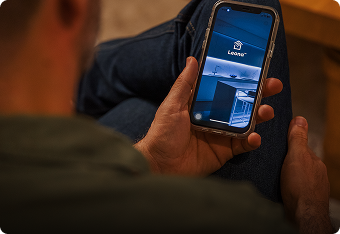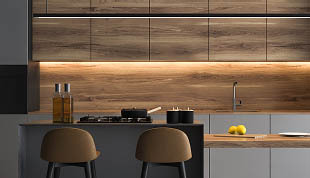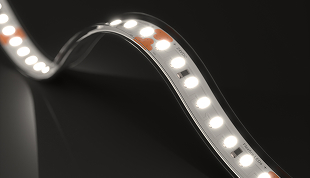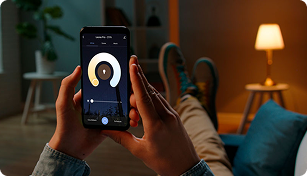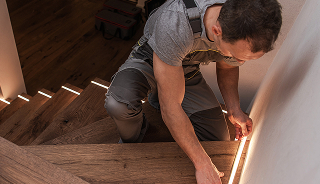LED Glossary
Explore commonly used terms in the LED industry
LED Glossary
Explore commonly used terms in the LED industry
Q:What are lumens (lm)?
Lumen is the measurement of brightness as perceived to the human eye. Because of incandescent lighting, we are all accustomed to using watts to measure the brightness of light. Today, we use lumen. Lumen is the most important variable when choosing which LED strip light you need to look at. Make sure you compare lumen output between LED strip lights before determining which one is best for your project.
Q: What is AC?
This is Alternating Current. This is the electricity that is used in most homes and commercial spaces. It’s often referred to as line voltage and number differs from country to country. US line voltage is typically 90V-220V, whereas it often averages higher in Europe.
Q: What is DC?
This is Direct Current. Most LED strips on the market use low-voltage DC. A transformer or low-voltage battery is often required to step-down the AC voltage to a suitable level for the LED strips, which is normally 12V or 24V DC.
Q: What is CRI and why is it important?
Color Rendering Index (CRI) is the measurement of how colors look under a light source when compared with sunlight. Having information on the CRI of a LED strip light is important because you want to make sure that the colors are being accurately represented by the light source. CRI is measured on a scale from 0-100. A CRI of 80+ is the industry-standard for most applications while a CRI of 90+ tends to be necessary for situations that need color accuracy. Our UltraBright High CRI Series are used for photography lighting, retail lighting, bathroom or salon lighting, and residential lighting. Read more about the importance of CRI, here.
Q: What is LED pitch and how does it affect the type of lighting I wish to achieve?
LED pitch is the distance between the individual chips on a strip (FPCB). It is absolutely crucial to understand the importance that pitch plays in your project. The shorter the pitch, the more uniform the light tends to be and the less spotting you have. To read and learn more about LED pitch click here.
Q: What is the difference between 3528 LEDs v 5050 LEDs?
LED chips are all not all equal. The four digits represent the size of the chips in millimeters. For example, the 3528 chip is 3.5 mm X 2.8mm. Some chips are brighter than other and some have special uses and restrictions. Read more about the difference in chip size here.
Q: What is color temperature?
The color of light can be quantified by referring to its color temperature. White light is measured in Kelvins (K). Most white lights fall in a spectrum between 1800K and 6500K. When getting close to 3000K, the light is noticeably warmer. On the other end of the spectrum, the lights have a blue-ish tint and cooler tone when nearing 6500K.
Q: What is mA or mAmp?
This is 1/1000 or 0.001 of 1 ampere. When using LED strips it is common that the current draw for the LEDs will be less than one amp. In this case milliamps are used to indicate the amp draw. An example of this would be that a draw of ½ amp would be equal to 500mAh.
Q: What is a Watt?
A watt is equivalent to one joule per second, corresponding to the power in an electric circuit in which the potential difference is one volt and the current one ampere. A watt is equal to the voltage multiplied by the amperage. This is how your electric company keeps track of how much energy you consume.
Q: What is Binning?
Simply put, binning is the process of grouping LEDs during production so that they matched with LEDs of the same color sector. For example, all 2700K chips are ‘binned’ together and are separated from chips that have a higher/lower color temperature. Learn more about Binning here.
Q: What is an LED (Light Emitting Diode)?
A Light Emitting Diode (LED) is a solid-state semiconductor device that converts electrical energy directly into light. To learn more about how an LED light produces light click here.
Q: What is solid-state lighting?
Lighting devices that do not contain moving parts or parts that can break, rupture, shatter, leak, or contaminate the environment. LEDs do not use electrical filiments or gasses to produce light.
Q: What is luminous efficacy?
This is calculated by measuring the lumen output and then dividing that number by watts. For example, a strip that has a lumen output of 300lm/ft and a wattage draw of 3w/ft has an efficiency of 100lm/W.
Q: What is a Luminous Intensity Distribution Diagram?
Is a test to determine the angle of an emitted beams of light. TM30 vs CRI page.
Q: What is an Isocandela diagram?
Graphic representation of brightness distribution of a light source. TM30 vs CRI page.
Q: What does Fidelity Index (TM-30) mean?
How closely the observed light can render colors like the sun, using 99 color samples. TM30 vs CRI page.
Q: What does Gamut Index (TM-30) mean?
How saturated or desaturated colors are (aka how intense the colors are).TM30 vs CRI page.
Q: What does Color vector Graphic (TM-30) mean?
Which colors are saturated/desaturated and whether there is a hue shift in any of the 16 color bins.TM30 vs CRI page.
Q: What does CQS - Color Quality Scale mean
An alternative to the unsaturated CRI measurement colors. There are 15 highly saturated colors that are used to compare chromatic discrimination, human preference, and color rendering. TM30 vs CRI page.
Q: What is a goniophotometer?
A photometric device for testing the luminous intensity distribution, efficiency and luminous flux of luminaires.
Q: What is IP stand for?
This is a rating system that defines the ability of a product to be able to work in different environments. IP is an acronym "Ingress Protection". It is a measurement of the protection an item will have against solid objects (dust, sand, dirt, etc.) and liquids.
An IP rating is comprised of 2 numbers. The first number refers to the protection against solid objects (dust, etc) and the second number refers to protection against liquids. Here is a complete article about IP ratings.
Q: What is the difference between IP65, IP67, & IP68?
The differences between commonly sold IP65, IP67, & IP68 strips are slight, but very important. Using the above chart as a guide, we can see that all strips are protected at the highest level from solids and dust. The variations come with the protection against liquids.
IP65 = Water resistant. “Protected against water jets from any angle” *Do NOT submerge IP65 LED lights, these are not waterproof.
IP67 = Water resistant plus. “Protected against the events of temporary submersion (10 minutes)”*Do NOT submerge IP67 LED lights for extended periods, these are not waterproof.
IP68 = Waterproof “Protected against the events of permanent submersion up to 3 meters”
Getting started with LED lighting? Between all components and connections, we know it can be a bit tricky at first. That’s why we put together this guide: to help you tackle some common issues on your own. But don’t worry—if things still aren’t clicking, we’re always here to lend a hand.
Let’s walk through each part of your setup with easy starting guidelines and step-by-step fixes for specific cases:
Adhesive VHB Backing
A super-strong, double-sided tape that helps LED strip lights stick to surfaces. VHB (Very High Bond) tape holds up well, even in tough conditions.
Alternating Current (AC)
The type of high-power electricity used in most homes and businesses. Devices like transformers convert it into Direct Current (DC) for your LED lights to work safely.
Ambient Temperature
The air temperature around your LED lights. Keeping it in the right range helps your lights last longer and work their best.
Accent Lighting
Lighting tailored for special features or areas in your space to make them stand out. It's great for subtle mood enhancement, around architectural details, or highlighting everyday essentials on shelves, display cabinets, and bookcases.
Addressable/Pixel/Digital LED Strip
An LED strip light featuring built-in pixels—small sections that can be controlled individually—for endless color changes, dynamic effects and patterns, and rich, vibrant tones. Ideal for high-level entertainment and decoration.
Aluminum Channel/Extrusion/Profile
An install accessory made from aluminum that houses and protects LED strip lights, improving heat management and providing a sleek, finished look.
Clear Diffusion: A see-through cover that keeps your strip light bright while still showing the individual LEDs. Great for indirect lighting, like cove lights or above cabinets.
Frosted Diffusion: A case that softens the light to reduce glare while keeping some LEDs visible. Perfect for under-cabinet lighting where you want a balance of brightness and smooth glow. It slightly dims your lights.
Matte Diffusion: A cover that creates an even, milky-white glow and hides individual LEDs completely. Best for direct-view lighting or reflective surfaces like countertops. It gently lowers brightness but removes glare for a comfortable look.
Amperage/Ampere
The measure of how much electricity flows through your LED install. The higher it is, the more power is being used.
Backlighting
LED strip lights placed behind something to create a glowing effect. You’ll often see it in signs, TVs, and decorative displays.
Beam Angle
The spread of light from an LED, measured in degrees. A narrow beam focuses light in one spot, while a wide beam covers a larger area.
Brightness Degradation
When lights slowly lose their brightness over time because of heat, long use, or aging materials.
Circadian Rhythm Lighting
Lighting designed to follow the natural pattern of daylight, helping your body wake up in the morning, feel energized during the day, and relax at night.
Coaxial Connector
A special type of plug that helps attach cables to power supplies or other cables while keeping the signal strong and protected. It’s designed to make sure electricity flows smoothly without interference.
Male Coaxial Connector: A plug that fits into its female matching socket.
Female Coaxial Connector: A small socket that receives a matching male plug.
Color Quality Scale (CQS)
A way to measure how well a light brings out colors, using 15 rich, vibrant shades. It helps assess how accurately and pleasantly colors appear under the light.
Color Rendering Index (CRI)
Our preferred way to measure how true-to-life your space’s colors appear under your LED lights. It’s rated on a scale from 0 to 100: 80+ is standard in most uses, while 90+ is ideal when color accuracy is key—like with artwork or detailed decor.
Controller
A device that helps you adjust the color, brightness, and effects of LED strip lights and fixtures, according to their features.
Cool White
A stimulating, crisp, blue-toned range of white light that keeps your focus and attention levels high, ideal for home tasks, office work, and public lighting in hospitals and airports. You'll find it in any product labeled 4500K and above.
Correlated Color Temperature (CCT)
Describes the shade of white of your LED lights. It's measured in Kelvins (K): lower numbers (1800-3000K) give off a cozy, golden glow, while higher numbers (4500K and above) create a sharp-focused effect.
Cove Lighting
Lighting that’s tucked away in hidden ceiling or wall nooks to create the desired amount of brightness without harsh glare.
Direct Current (DC)
A type of electricity with a lower, steady power level that most LED strips use. Since your home’s Alternating Current (AC) power is stronger, your strips need a transformer to work safely with it.
Dim-to-Warm
A feature that allows some LED strip lights to shift to ultra-warm shades of white as they are dimmed, matching the tone of traditional light bulbs and easing sleep and relaxation.
Dimmer
A device that lets you adjust the brightness of your LED lights by controlling the power they receive.
Direct Lighting
Lighting that shines straight onto surfaces or objects, giving you clear and focused light exactly where you want it.
DMX
An advanced system used to control lights in big events like concerts, shows, or displays, helping adjust pro-level effects and patterns.
Downlight
A light that’s under or built into the ceiling and shines light down onto your space, great for overall room lighting.
Dynamic Tunable White Lighting
LED lighting that allows you to adjust your light’s shade of white to your liking and needs, from warm and yellow or cool and crisp.
ETL-Listed
A product tested by Intertek (Electric Testing Laboratories) that meets the same safety standards as UL-Listed items but is certified by a different lab.
Fidelity Index
This tells you how well your LED lights can show colors as they would appear in natural sunlight. It’s measured using 99 different colors to check for accuracy. The higher the score, the more true-to-life the colors look.
Flicker
Quick changes in light brightness, usually due to mismatched dimmers or power sources, which can irritate the eyes.
Gamut Index
A measurement of how many colors your LED lights can show accurately. The higher the number, the more colors you’ll see the way they’re meant to look.
Heat Dissipation
The process of directing heat away from your LED strips using materials like aluminum to keep them working efficiently and lasting longer.
Heat Sink
An accessory, such as our aluminum mounting channels, that helps pull heat away from your LED strips to keep them working efficiently.
Indirect Lighting
Light bouncing off walls or ceilings instead of shining directly on its surroundings. It creates a softer, more even glow that reduces glare and boosts a space's ambiance.
Ingress Protection (IP)
A rating system that measures how well your LED lights and install accessories are protected from the weather, liquids like water, and solid particles like dust and dirt. All our products are labeled with their specific rating, which includes the letters "IP" followed by a number:
IP65: Built to handle splashes, humidity, and low-pressure water jets but not full soaking.
IP67: Handles high-pressure water jets.
IP68: Fully waterproof for continuous soaking up to 3 meters.
Junction Box
A protective casing that houses electrical connections and keeps wiring safe.
Kelvin
The temperature unit of measurement that describes how warm and yellow or cool and crisp a light looks.
LED Chip
A tiny light-producing part inside an LED that glows when powered.
2835: A small, efficient LED chip (2.8 mm x 3.5 mm) that provides good brightness while saving energy.
3528: A compact LED chip (3.5 mm x 2.8 mm) tailored for moderate brightness and energy use, often used in strips designed for accent lighting.
5050: A larger LED chip (5.0 mm x 5.0 mm) that contains three tiny lights in one, making it great for vibrant color-changing strip lighting.
LED Chip Density
The number of tiny LEDs packed into a set length of your LED strip, affecting how bright and even the light looks.
LED Lifespan
How long your LED lights are expected to last before their brightness starts to fade, usually measured in hours.
LED Light Bar
A sturdy LED casing with a diffused cover that spreads light evenly and prevents dark spots, ideal for under-cabinet lighting, displays, and accent lighting.
LED Pitch
The distance between the individual LEDs on your strip light. The shorter it is, the more uniform your lights tend to be and the less spotting you have.
LED Sheet
A thin, flexible panel with built-in LEDs that can be cut to size, perfect for backlighting and signs.
LED Sign Module
A flexible chain of medium-bright LEDs with a slim design for indoor and outdoor business use, perfect for all kinds of signage solutions.
LED Strip Light/LED Tape Light
A bendable, thin, multi-purpose copper ribbon lined with LEDs, designed in multiple colors, power, and brightness levels. This is where our company began, and it is still our signature product.
Light Emitting Diode (LED)
A small but powerful light source that uses electricity efficiently to produce bright, long-lasting illumination.
Light Fixture/Luminaire
A complete light structure with LEDs, a protective casing, and all the parts needed to work right out of the box.
Lumen
A unit of measurement for light brightness. It helps you choose the right LED strip for your needs.
Lumen-Dirt Depreciation
The decrease in brightness over time caused by dust and dirt building up on your LED strip.
Luminous Efficacy
A measure of how well a light turns energy into brightness. It’s calculated by dividing brightness levels by the power used.
Maximum Run Length
The longest distance an LED strip can run while staying fully bright and working correctly.
Mounting Brackets/Clips
Accessories used to secure your LED strip lights in place for a secure, long-lasting install.
Mood Lighting
Lighting that creates specific ambiances or enhances the feel of a space. It often uses soft, indirect, or color-changing light to match your feelings and add comfort and style. Common in homes, hotels, and entertainment areas.
Natural White
A well-balanced range of white light that resembles sunlight, creating a clear, inviting space with the right mix of sharp focus and warmth. You'll find it in any product labeled 4000-4500K.
Operating Temperature
The temperature range where your LED lights work safely and efficiently.
Power Supply/Driver/Transformer
A device that converts your home’s or business’s higher electric power into a level your LED strips and fixtures can handle, ensuring they work correctly.
Dimmable Driver: Connects to a hardwired dimmer switch that is linked to your space's electrical system. It works with compatible dimmers to smoothly adjust the brightness of your LED lights without flickering or performance issues.
Non-Dimmable Driver: Connects directly to your space's electricity without a dimmer switch in between. Using it with one can cause flickering, reduce lifespan, or lead to failure. The brightness of your LED strip lights cannot be adjusted unless you use a smart app, remote, or wall panel.
Printed Circuit Board (PCB)
The surface that holds and connects your LED strips’ tiny lights, allowing them to work together.
Puck Light
A compact, round LED light perfect for shelf accents and under-cabinet lighting.
Recessed Lighting
Lighting installed into ceilings, walls, cabinets, shelves or bookcases for a flush, built-in appearance.
Retrofit
The process of upgrading existing appliances, furniture, or setups in your spaces with LED lighting and technology.
Radio Frequency (RF)
A wireless technology used for your LED controllers to adjust your lights’ brightness, colors, and effects without pointing the remote directly at the lights.
RGB
A color-changing lighting option.
RGB + Dynamic Tunable White
A color-changing LED lighting option plus wide-ranging, warm-to-cool shades of white.
RGBW
A color-changing LED lighting option plus a set, warm or cool hue of white.
Soldering
The process of melting a metal alloy to join electrical components, like connecting your LED strips to power or other strips.
Solder Pads
Small metal contact points on an LED strip where wires or connectors attach.
Solderless Connector
A hassle-free, clip-on tool for joining your LED strips.
Task Lighting
Lighting designed for studying, handiwork, reading, cooking, and other activities requiring sharp focus.
UL-Listed
A product that has been tested by Underwriters Laboratories (UL) and meets safety standards for use as a complete, standalone unit.
UL Recognized-Component
Individual parts, like power supplies or dimmers, that meet UL safety standards but need to be part of a larger, approved system.
UV Light
Also called ultraviolet light, this vibrant, purplish glow is great for setting moods in homes or businesses. It can also bring out hidden colors and details in things like cleaning, money inspection, resin art, and rock collecting. Our UV lights are safe for your eyes and overall well-being.
Uplight
Light pointed upward to brighten ceilings or walls.
Voltage
The force that makes electricity move through wires. It’s measured in volts (V). The higher it is, the more electricity gets sent to power up your LED lights.
Voltage Drop
When your LED strips run longer than recommended and their power weakens, making the lights dim at the far end.
Warm White
A gentle, golden-to-yellow range of white light that makes any space feel cozy and intimate, ideal for relaxation. You'll find it in any product labeled 2700-3500K.
Water-Resistant
Built to handle splashes, humidity, and low-pressure water jets but not full soaking. All products with an IP65 label will have this protection.
Watt/Wattage
It’s a unit that measures power—how much electricity your LED strips will use. The higher the number, the more energy they need. Your electric company uses this to track your energy use.
Need Help?
If there’s a term you need help with—or one you think we should add—don’t worry! Just contact us.



